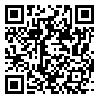Volume 11, Issue 1 (Autumn 2025)
Health in Emergencies and Disasters Quarterly 2025, 11(1): 47-52 |
Back to browse issues page
Ethics code: IR.USWR.REC.1402.193
Download citation:
BibTeX | RIS | EndNote | Medlars | ProCite | Reference Manager | RefWorks
Send citation to:



BibTeX | RIS | EndNote | Medlars | ProCite | Reference Manager | RefWorks
Send citation to:
Mortazavi M, Farzinnia B, Nasiri A, Farrokhi M, Saatchi M, Khankeh H. Public Safety Answering Point Models: A Scoping Review Protocol to Explore National and International Experiences. Health in Emergencies and Disasters Quarterly 2025; 11 (1) :47-52
URL: http://hdq.uswr.ac.ir/article-1-610-en.html
URL: http://hdq.uswr.ac.ir/article-1-610-en.html
Morteza Mortazavi1 

 , Babak Farzinnia *2
, Babak Farzinnia *2 

 , Ali Nasiri3
, Ali Nasiri3 

 , Mehrdad Farrokhi4
, Mehrdad Farrokhi4 
 , Mohammad Saatchi5
, Mohammad Saatchi5 
 , Hamidreza Khankeh4
, Hamidreza Khankeh4 




 , Babak Farzinnia *2
, Babak Farzinnia *2 

 , Ali Nasiri3
, Ali Nasiri3 

 , Mehrdad Farrokhi4
, Mehrdad Farrokhi4 
 , Mohammad Saatchi5
, Mohammad Saatchi5 
 , Hamidreza Khankeh4
, Hamidreza Khankeh4 


1- Health in Emergency and Disaster Research Center, Social Health Research Institute, University of Social Welfare and Rehabilitation Sciences, Tehran, Iran. & Unit of Crisis Management and Passive Defense Planning, Department of Crisis Management and Passive Defense, Shiraz Municipality, Shiraz, Iran.
2- Health in Emergency and Disaster Research Center, Social Health Research Institute, University of Social Welfare and Rehabilitation Sciences, Tehran, Iran. ,Ba.farzinnia@uswr.ac.ir
3- Health in Emergency and Disaster Research Center, Social Health Research Institute, University of Social Welfare and Rehabilitation Sciences, Tehran, Iran. & Department of Health in Disasters and Emergencies, School of Health, Baqiyatullah University of Medical Sciences, Tehran, Iran.
4- Health in Emergency and Disaster Research Center, Social Health Research Institute, University of Social Welfare and Rehabilitation Sciences, Tehran, Iran. & QUEST Center for Responsible Research, Berlin Institute of Health at Charite, Berlin, Germany.
5- Health in Emergency and Disaster Research Center, Social Health Research Institute, University of Social Welfare and Rehabilitation Sciences, Tehran, Iran.
2- Health in Emergency and Disaster Research Center, Social Health Research Institute, University of Social Welfare and Rehabilitation Sciences, Tehran, Iran. ,
3- Health in Emergency and Disaster Research Center, Social Health Research Institute, University of Social Welfare and Rehabilitation Sciences, Tehran, Iran. & Department of Health in Disasters and Emergencies, School of Health, Baqiyatullah University of Medical Sciences, Tehran, Iran.
4- Health in Emergency and Disaster Research Center, Social Health Research Institute, University of Social Welfare and Rehabilitation Sciences, Tehran, Iran. & QUEST Center for Responsible Research, Berlin Institute of Health at Charite, Berlin, Germany.
5- Health in Emergency and Disaster Research Center, Social Health Research Institute, University of Social Welfare and Rehabilitation Sciences, Tehran, Iran.
Abstract: (1625 Views)
As public safety answering points (PSAPs) have become the elementary contact point between clients and rescue service providers, the planning of the call center has become a key task for administrators. Connect call centers accelerate dispatch center performance, particularly during an overloaded period. The efficient dispatch of emergency medical services and prompt response to urgent requests could be achieved with their help. This study aims to explore national and international experiences to identify PSAP models and their key dimensions. In this research, Arksey and O’Malley’s five-step framework will be followed. Additionally, incorporating the PRISMA extension into this scoping review will allow us to extensively investigate the available literature on PSAP models up until the year 2024. For this purpose, a comprehensive review will be conducted using PubMed, Web of Science, and Scopus to examine officially published reports. In addition, grey literature will be sourced from Google Scholar, the World Health Organization (WHO) website, and relevant regional offices.
Type of article: Review |
Subject:
Emergency
Received: 2024/03/9 | Accepted: 2025/03/12 | Published: 2025/10/1
Received: 2024/03/9 | Accepted: 2025/03/12 | Published: 2025/10/1
Send email to the article author
| Rights and permissions | |
 |
This work is licensed under a Creative Commons Attribution-NonCommercial 4.0 International License. |





